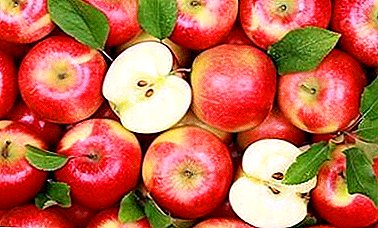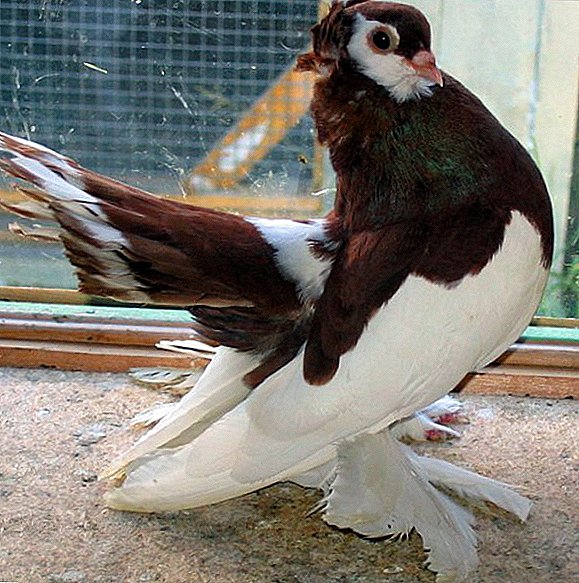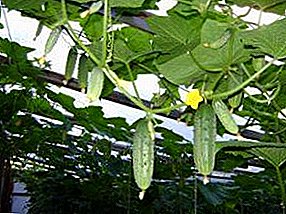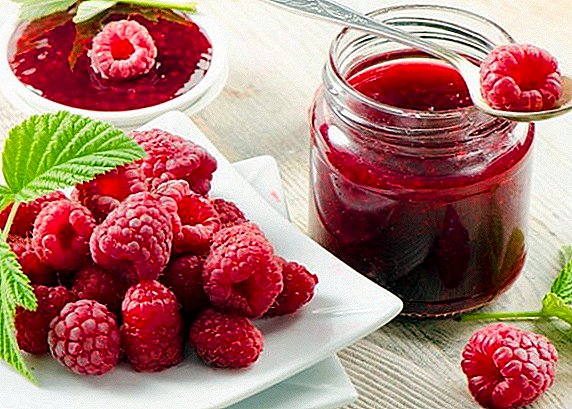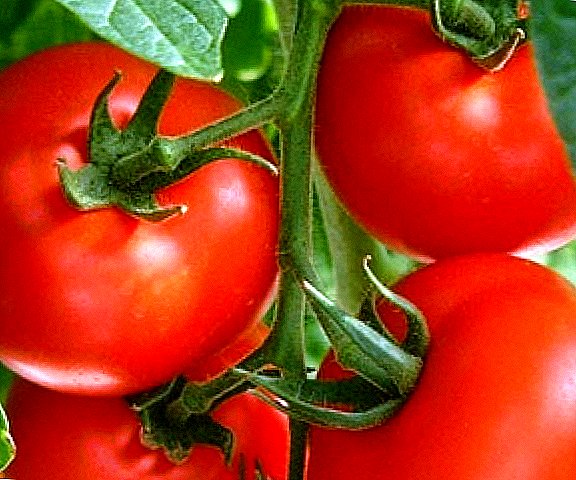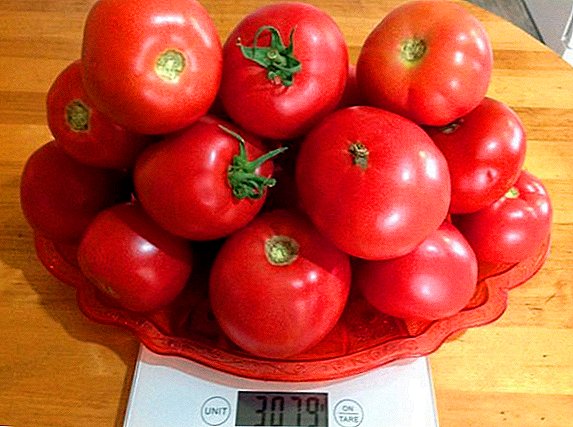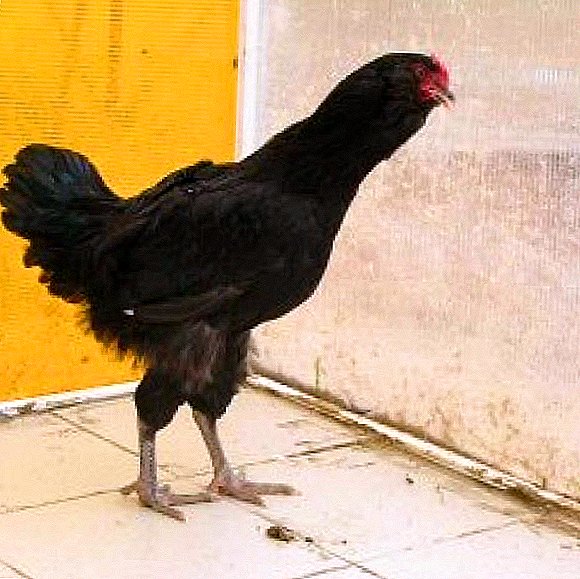 Raspberries have always been famous not only for tasty and beautiful berries, but also for their benefits to the human body, and to enhance these qualities, people still bring new and new plant varieties. One of the most useful options is raspberry "Balsam", and you will find out how it is remarkable and how to ensure yourself with a good supply of useful berries - in the article.
Raspberries have always been famous not only for tasty and beautiful berries, but also for their benefits to the human body, and to enhance these qualities, people still bring new and new plant varieties. One of the most useful options is raspberry "Balsam", and you will find out how it is remarkable and how to ensure yourself with a good supply of useful berries - in the article.
Variety description
Raspberry "Balsam" is an upright, but very sprawling bush of average height (in a temperate climate, its height usually does not exceed 1.8 m). Annual shoots are fairly thick, green in color, while biennial shoots are already highlighted in light brown color. On 1 m² of territory the plant forms about 15-20 shoots with a pronounced wax coating on them. All of them are medium-studded, with hard shortened spikes of brown color.
In addition to red raspberry varieties, yellow and black raspberries are also found in home gardening, with many beneficial properties.
The sheet plates of the described raspberry are not too wrinkled and in most cases are quite large. From above, they are dark green and dull, and from below they are lighter, heavily pubescent, with subtle soft spikes of a light purple color (they stretch along the main veins of the leaves).  The plant has not only good taste, but also has the ability to have a beneficial effect on the entire human body, since it is characterized by antipyretic, anti-inflammatory and antioxidant properties. In addition, in its composition there are many important vitamins and minerals, among which especially distinguish vitamins A, B2, PP, E, folic acid.
The plant has not only good taste, but also has the ability to have a beneficial effect on the entire human body, since it is characterized by antipyretic, anti-inflammatory and antioxidant properties. In addition, in its composition there are many important vitamins and minerals, among which especially distinguish vitamins A, B2, PP, E, folic acid.
Did you know? The Balsam variety was obtained thanks to the crossing of Newburgh with the Ruby Bulgarian, and it was added to the State Register of Russia in 1993.
A distinctive feature of the Balsam is its good winter hardiness, which allows it to maintain freshness and avoid evaporation in the coldest winters. In addition, the plant successfully survives thawing and flooding of the root system, albeit with minimal precipitation.  This variety is successfully grown throughout the territory of the Russian Federation and Ukraine, and the exception may be only the Ural, Northern and Far Eastern regions of Russia.
This variety is successfully grown throughout the territory of the Russian Federation and Ukraine, and the exception may be only the Ural, Northern and Far Eastern regions of Russia.
Characteristics of berries and yield
Ripe raspberry "Balsam" is a dark-purple berries of medium size, weighing 2.6-2.8 g. All alone are one-dimensional, have a wide conical shape and dense structure. In a state of full maturity, they are very well separated from the stem and have good taste data (pulp is sour-sweet), but the flavor is insignificant.
We advise you to read the benefits of raspberries.
As for productivity, in this case it is much higher than the average and is about 60-80 centners from 1 hectare of plantations, and with good care this figure can increase to 10.5-12.1 t / ha. When grown in a private area with one bush, you can get 2.5-2.7 kg of ripe and tasty berries. All fruits ripen almost simultaneously, so that with small quantities at a time they harvest the entire crop. 
Agrotehnika cultivation and care for raspberries
To get the maximum amount of delicious and healthy raspberry berries, it is important to provide the bushes with the most comfortable conditions for growth and development. In addition to agrotechnical techniques (meaning proper care of plants with compliance with the requirements for watering, feeding and pruning), it is also important not to make a mistake in choosing the seedlings themselves, therefore we will start with this question.
Raspberry varieties such as Heritage, Barnaul, Ispolin, Pride of Russia, Canadian, Kirzhach, Polka, Atlanta, Cumberland, Tiberberry and Caramel".
Selection of seedlings
Not all copies sold on the market are completely viable and will feel good in the conditions of your garden. Some of them could be damaged during transportation, while others may already be infected with any diseases or pests. To distinguish completely healthy seedlings from problem ones, it is important to know exactly what you are looking for. In the case of the raspberry "Balsam", you need copies with the following characteristics:
- medium thick;
- with well developed rhizome;
- with one or more fully formed stems.
 If your chosen seedling has an open root system, then during transportation the rhizome should be wrapped with a damp cloth, and on arrival at the site immediately prikopyat. Also do not forget that a long content in plastic bags or burlap is highly undesirable, as the roots will begin to rot, and the seedling will become unsuitable for further use.
If your chosen seedling has an open root system, then during transportation the rhizome should be wrapped with a damp cloth, and on arrival at the site immediately prikopyat. Also do not forget that a long content in plastic bags or burlap is highly undesirable, as the roots will begin to rot, and the seedling will become unsuitable for further use.Important! You do not need to buy very large raspberry bushes, as it will be difficult for them to adapt to the new territory.
Conditions of detention
Choosing a site for planting and further maintenance of plants, you should pay attention only to the areas well-lit by the sun and protected from the wind, where in wintertime snow drifts are most often formed. Landing pits are recommended to be placed in the direction from the north-east to the south-west, and also from north to south. The soil in these areas should be slightly loamy, and sandy and sandy sandy soils will have to be watered and fertilized regularly with organic matter. 
Soil and fertilizer
Before planting seedlings in the prepared hole, the soil in it must be fertilized with peat, humus, organic matter, wood ash, rotted manure or chicken droppings. Also a good solution would be the combination of organic matter with mineral compounds, among which the most prominent are superphosphate (150-200 g) and potassium (60-80 g). Fresh cow dung is out of place here.
If during planting you have brought a sufficient amount of nutrients to the soil, in the first two years it is not necessary to carry out top dressing. Since the third year of growth of "Balsam", every spring the soil under the raspberries must be flavored with nitrogen-containing compounds. In the process of forming fruit-bearing bushes, potash and phosphate fertilizers (50-60 g per square), superphosphate, potassium sulphate and wood ash are used (it is enough to just wake up the soil). Also, a good effect gives the introduction of organic compounds in the form of rotted manure diluted in water 1:10. 
Watering and moisture
Raspberry "Balsam" loves moisture, so they water it every week, using 30-40 liters of water for each square meter of land. In addition, abundant watering is required for plants and immediately after planting, which will contribute to their good survival.
Did you know? If the raspberry grows close to the apiary, then we can hope for a relatively high yield, because, collecting nectar, the bees increase these figures by 40-60%.
Relation to temperature
In most regions of the average climate zone, raspberries of the described variety tolerate winter frosts well, but the north you are, the more likely it is that you will need shelter. Shoots should not rise above 30 cm above the ground, and they can be fixed with the help of powder, tied to a support or special pegs. In particularly harsh winters, you can use spandex for shelter.
Reproduction and planting
Raspberry seedlings are planted at the site in spring or autumn, and green cuttings are planted in summer. The soil for planting is prepared in advance, and during the autumn planting - about a month. If you plan to plant bushes in the spring, then the preparatory activities will have to take care in the fall. In extreme cases, this can be done with the arrival of the first heat, but only necessarily 2-3 weeks before the intended landing. 
The process itself can be performed according to the classical scheme, with a distance between bushes of 70-100 cm, by a tape method (interval 200-220 cm) or by a bush (1.5 m between the bushes).
If you want raspberry bushes to grow and develop properly, learn how to plant raspberries in the fall and spring.
As for breeding, in this raspberry "Balsam" is also quite a profitable representative of its kind. It is easy to dissolve on the site in various ways: using lignified and green cuttings, rhizome and dividing the bush. One of the most popular methods is cutting off the young process 20 cm high from the mother plant with further planting (together with the earthy ball) in a new place. Planting site abundantly watered, mulched and shaded. 
Pruning
Variety "Balsam" refers to the fruiting raspberry varieties, so the plants will have to be cut regularly, during the entire warm season. This procedure is carried out in several stages:
- After harvesting, all two-year-old bark-covered shoots are removed from the bushes (they should have already been planted in the current year), and to avoid the spread of a possible infection, they are immediately burned, having previously been taken away.
- The next pruning comes in deep autumn. During this period, cut off all unnecessary, dry and diseased shoots, destroying them after that as described above.
- In the middle of May they usually pinch the tops of two-year shoots, stimulating the development of new branches.
- With the arrival of summer next year from the raspberry "Balsam" you need to remove the growth, using a sharp spade.
 Do not forget about the valuation, with cutting the weakest and smallest shoots in a row. As a result, no more than 10 of them should remain on one running meter.
Do not forget about the valuation, with cutting the weakest and smallest shoots in a row. As a result, no more than 10 of them should remain on one running meter.For the successful cultivation of raspberries, it must be properly cut.
Growing difficulties and recommendations
The main problem in growing the Balsam variety is a large mass of long shoots, forcing them to lean towards the ground itself. In order not to break off the branches, it is necessary to use supports, and sometimes even several species in one growing season. Most often, a support stake is driven into the center of the raspberry bush, and already dropping parts of the plant are tied to it. However, the main disadvantage of this method is a reduction in the illumination of the inner part of the bush and, as a result, its overall yield.  Partially solve this problem will help fan placement of shoots, when between different bushes drive in pillars and tie them to half of all branches of each of them, but it is better to pull the wire or organize a trellis garter (crimson shoots are attached to the supports in early spring, before the buds).
Partially solve this problem will help fan placement of shoots, when between different bushes drive in pillars and tie them to half of all branches of each of them, but it is better to pull the wire or organize a trellis garter (crimson shoots are attached to the supports in early spring, before the buds).
Important! Plants varieties are very sprawling, so for the comfortable development of each of them you have to ration the number of shoots. The optimal value is 8-10 pieces per square meter of land.
Other significant problems in the cultivation of varieties "Balsam" was not found, so it is suitable for cultivation by both experienced and novice gardeners.
Pests, diseases and prevention
Like many other varieties, the described raspberry often suffers from such a common pest as the raspberry beetle, which does not allow the berries to grow and develop normally. To get rid of it, gardeners simply shake off an insect from branches on a plastic film or use shop insecticides.  Not less damage to plantings can cause stem leaf and weevil florist. Weevil larvae spoil the peduncle, gnawing at it, because of which the buds fall, and the harvest is significantly reduced. Already pupated individuals gnaw at the end of summer crimson leaves and go underground for the winter, and to prevent their activity next year, the soil under the bushes must be loosened, mixed with snow.
Not less damage to plantings can cause stem leaf and weevil florist. Weevil larvae spoil the peduncle, gnawing at it, because of which the buds fall, and the harvest is significantly reduced. Already pupated individuals gnaw at the end of summer crimson leaves and go underground for the winter, and to prevent their activity next year, the soil under the bushes must be loosened, mixed with snow.
Important! The best option for pruning when growing raspberry cultivar "Balsam" is a double scheme: with the arrival of summer, all the shoots are cut by 10-15 cm, and a year later the lateral growths are cut off at the same distance.
Ignoring the problem of gall midge can lead to the death of the entire raspberry plantation. You can prevent undesirable consequences by regularly inspecting the bushes, cutting out damaged shoots, and treating raspberries with a 1% solution of Bordeaux mixture.
Another pest that is often found on plantations is raspberry aphid. In addition to damage to plants, the insect is able to transfer to them any viral ailment characteristic of other cultures. To get rid of this problem, gardeners use special insecticides against aphids, and when the fruit ovary is additionally treated the bushes with infusions of dandelion, tobacco, orange peels and bitter wormwood.  As for the common fungal diseases, the "Balsam" variety has a high resistance to them and is practically not affected. If suddenly this happens, standard fungicides will help to cope with the problem: for example, "Mikosan" or "Fundazol".
As for the common fungal diseases, the "Balsam" variety has a high resistance to them and is practically not affected. If suddenly this happens, standard fungicides will help to cope with the problem: for example, "Mikosan" or "Fundazol".
Find out what diseases you may encounter while growing raspberries.
In general, the described raspberry variety is a good option for growing on a personal plot: the plants are unpretentious, resistant to diseases and bring a bountiful harvest. However, if you like very sweet berries, then you have to look for another variety, as in this case the acidity will still be felt.
Video: raspberry varieties "Balsam"
Feedback from users of the network about raspberry varieties "Balsam"



